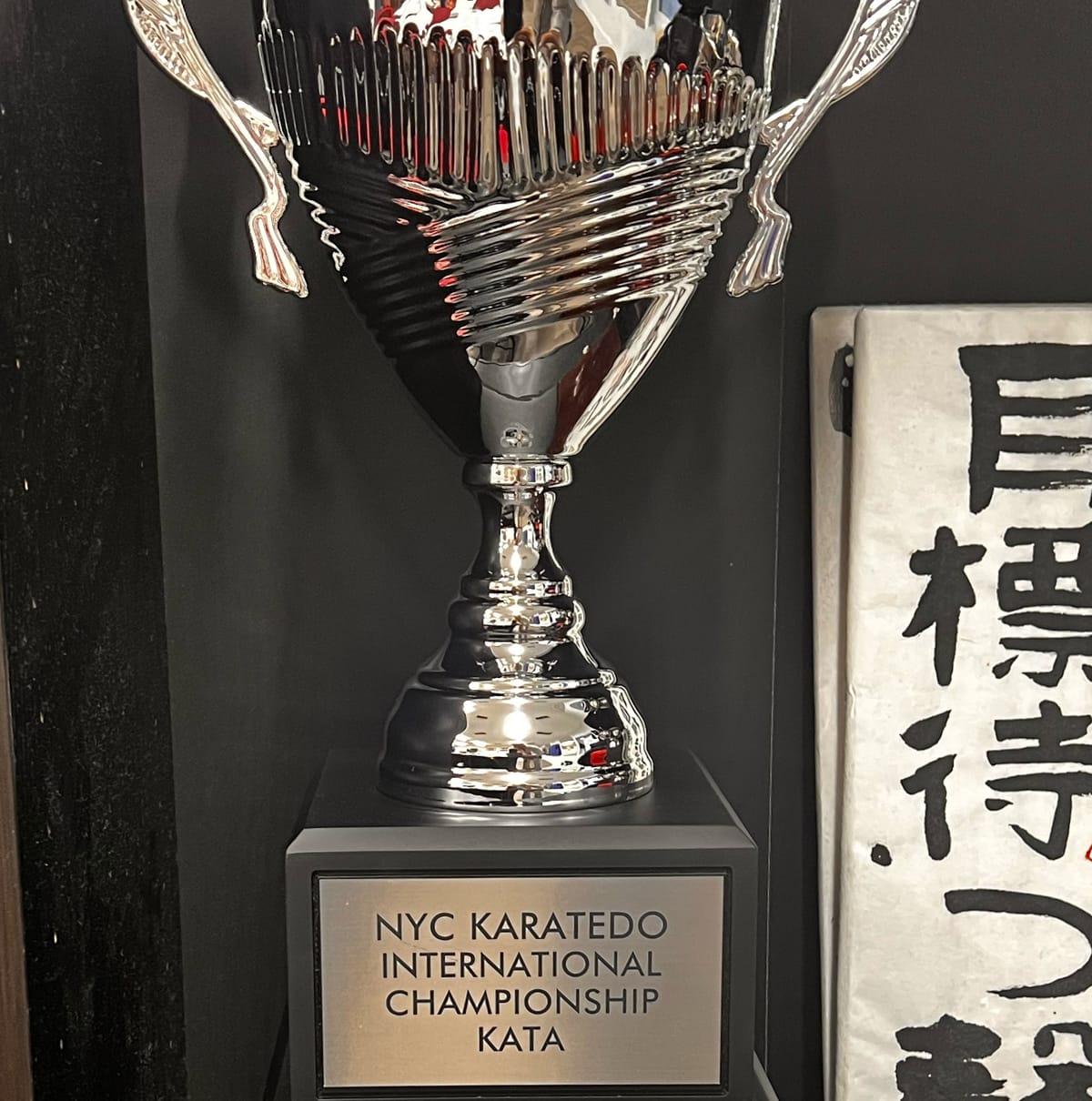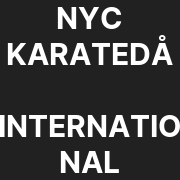The 2025 NYC Karatedō International Championship Tournament is on Saturday, November 8th and Sunday, November 9th, 2025, at Goju Karate. These are the rules for the Kata competition.
Goju Karate is proud to host the 2025 edition of the NYC Karatedō International Championship Tournament on Saturday, November 8th, 2025 and Sunday, November 9th, 2025 at the Goju Karate dojo.
The rules are detailed below, and are also available as a PDF file.
KATA
Official Competition Rules
Version: 2025-10B
This version replaces Version 2025-10A
Last revised: October 2025.
The rules of Kata competition for all tournaments, matches, and competitions shall be as stated herein.
This version was published on October 29, 2025. This version replaces all other versions. It is designated Version 2025-10B.
Section 1: COMPETITION RULES
These rules have been developed by the Karatedō Kizuna Association (KKA) for all international, national, and local competitions in Kata. They are also the official rules of the kata competition of the New York Karatedō International Championship.
These rules follow the general form of competition rules that many international and national organizations use for kata, kumite, and kobudo. However, these rules have been created and maintained in order to ensure that any tournament events that are held under these rules conforms to the spirit and substance of karatedō. While tournaments are, by their very nature focused on competition and sport, such sport must conform to the essence and purpose of karatedō. And further, such sport must be conducted to the benefit of the demonstration of the value and values of karatedō and to ensure the safety of competitors.
Whenever a specific rule specified herein is in conflict with a more general rule, the specific rule takes precedence. Exceptions to these rules may be made only with the prior approval of the Tournament Referee Committee for special circumstances attendant to a particular event, tournament, match or competition. In that event, however, the rules modifications shall be made known to all competitors prior to registration, or if made after registration, in a timely manner.
Ultimately, the Tournament Director makes the irrevocable final determination regarding the implementation, enforcement, and interpretation of these rules. However, he may appoint as many Chief Referees, Referees, Scorekeepers, Timekeepers, and other Tournament Officials as may be required to perform his duties.
Section 2: COMPETITOR CATEGORIES
Kata competition may be divided into appropriate categories or divisions based upon age, gender and experience.
At a minimum, all competitions must be divided into a male and female division, and if non-adult competitors are present, into, at a minimum, a Kids Division and an Adults Division. In addition, if competitors designated as members of the Mentor Division are present, there must also be a Mentor Division.
However, these are the mimics: at the sole discretion and decision of the Tournament Director, some or all divisions may be organized according to rank (e.g. blackbelt divisions) and even some divisions may be further subdivided by age (e.g., Adult Men’s Division, 18-40; Adult Men’s Division, 40+).
In general, and at the sole discretion and decision of the Tournament Director, kids will be organized by age group.
A. Junior competitors are defined as boys or girls who have reached a minimum age of 4 on the day of competition, and who are not 8 years of age on the day of competition. The Tournament Director may authorize exceptions to this rule and reclassify a competitor as eligible (in the case of a competitor outside the age range of 4-7) or ineligible, as the case may be.
As stated above, there must be a Male (boys) Juniors Division and a Female (girls) Juniors Division.
In the event that the Male (boys) Juniors Division or the Female (girls) Juniors Division is too small, in the sole judgment of the Tournament Director, members of either Division may compete against one another. However, in the final determination of Division winner, there must be a separate winner in each division regardless of the number of competitors in that division, assuming there is at least one member of the division. This is not true, however, for rounds of competition within a division: at the discretion of the Tournament Director, all competitors may compete and be awarded appropriate awards even if all the competitors are of different genders.
B. Mentor competitors are defined as boys or girls who have reached a minimum age of 4 on the day of competition, and who are not 22 years of age on the day of competition. Further, they are competitors who require special accommodation in order to compete: specifically, members of this division compete with the assistance of a “mentor” — another karateka who assists in competition in any way required to aid the Mentor competitor to demonstrate his or her best karatedō.
The Tournament Director may authorize exceptions to this rule and reclassify a competitor as eligible (in the case of a competitor outside the age range of 4-22) or ineligible, as the case may be.
This Division is the sole division that, at the discretion of the Tournament Director, does not have to be divided by gender.
C. Youth competitors are defined as boys or girls who have reached a minimum age of 8 on the day of competition, and who are not 12 years of age on the day of competition. The Tournament Director may authorize exceptions to this rule and reclassify a competitor as eligible (in the case of a competitor outside the age range of 8-11) or ineligible, as the case may be.
As stated above, there must be a Male (boys) Youth Division and a Female (girls) Youth Division.
In the event that the Male (boys) Youth Division or the Female (girls) Youth Division is too small, in the sole judgment of the Tournament Director, members of either Division may compete against one another. However, in the final determination of Division winner, there must be a separate winner in each division regardless of the number of competitors in that division, assuming there is at least one member of the division. This is not true, however, for rounds of competition within a division: at the discretion of the Tournament Director, all competitors may compete and be awarded appropriate awards even if all the competitors are of different genders.
D. Teen competitors are defined as boys or girls who have reached a minimum age of 12 on the day of competition, and who are not 18 years of age on the day of competition. The Tournament Director may authorize exceptions to this rule and reclassify a competitor as eligible (in the case of a competitor outside the age range of 12-17) or ineligible, as the case may be.
As stated above, there must be a Male (boys) Teens Division and a Female (girls) Teens Division.
In the event that the Male (boys) Youth Division or the Female (girls) Youth Division is too small, in the sole judgment of the Tournament Director, members of either Division may compete against one another. However, in the final determination of Division winner, there must be a separate winner in each division regardless of the number of competitors in that division, assuming there is at least one member of the division. This is not true, however, for rounds of competition within a division: at the discretion of the Tournament Director, all competitors may compete and be awarded appropriate awards even if all the competitors are of different genders.
E. The Adults Division shall consist of competitors who have reached the age of 18 or more on the day of competition. As stated above, there must be a Male Adults Division and a Female Adults Division.
F. The ultimate placement of karateka athletes in the correct rank and ranges is the responsibility of both the athletes, their instructors, and the Tournament Director and the Tournament Referees. Any dispute arising out of the classification of competitors shall follow the dispute resolution procedure as outlined in these rules.
Section 3: APPROVED KATA
The Tournament Director shall cause to be issued a list of the kata that may be performed by any competitor. Further, at his sole discretion, the Tournament Director shall restrict some kata to certain divisions.
Section 4: APPROVED COMPETITOR AND REFEREE UNIFORMS AND DRESS
Provisions are made to ensure that both competitors and referees reflect the discipline, tradition, and values of karatedō.
A. All competitors shall conform to the following uniform:
Standard white karate gi consisting of a gi jacket, gi pants, and rank belt.
The rank belt shall be the standard rank belt awarded to the competitor by his or her dojo and shall reflect their current rank. Under no circumstances may a red belt be worn. The only colors permitted on a rank belt are: white, blue, yellow, green, brown, purple, orange, and black. Stripes indicating rank, rank bars, kanji, and other standard symbols may be present on belts. Variations of belts that include white rows in the middle and white rows on the top and bottom of belts is permitted for any non-Adult Division competitor. No other colors or patterns are permitted to be worn.
The gi may be of any manufacture and of any weight desired by the competitor.
The gi shall display appropriate dojo affiliation patches in the chest area and on one or more shoulders, if applicable to the dojo that the competitor is affiliated. If the competitor is a member of the USOC NKF, then the competitor may wear a USOC-approved patch on his or her right shoulder. If the competitor is a member of another country-specific internationally recognized karatedō organization, then the competitor may wear a similarly supplied patch on his or her right shoulder.
Manufacturer’s logos may be displayed provided that they are (a) discrete; (b) pertain solely to the manufacturer of the gi; (c) are embroidered onto the gi as shipped from the manufacturer and have not been added after manufacture. Red and Blue sport symbols, even if embroidered and original to the gi, are not permitted.
No other patches, advertising materials, or other symbols may be displayed or worn on any part of the uniform, including but not limited to the back of the uniform.
In the event that a competitor has his or her name (in characters or letters) embroidered on their gi jacket hem or on their pants, such name embroidery shall be permitted provided that it is of reasonable size, color, and substance – such determination of suitability shall be solely at the discretion of the Tournament Director.
In the event that the competitor is affiliated with a dojo that utilizes a black gi instead of a white gi, a black gi may be worn provided that (a) it conforms to all other provisions of this section; and (b) prior permission to do so has been received in writing from the Tournament Director or his representatives.
In addition to the above, the following provisions regarding dress in regards to competitors shall be followed:
No shoe, sock, or other foot covering shall be worn.
No competitor may wear any covering, including tape of any kind.
B. At the direction of the Tournament Director, referees, judges, and other tournament officials including ring managers, timekeepers and scorekeepers, shall conform to one of the following standards of uniform and dress.
EITHER:
The standard karatedō uniform as specified in Section 4(a).
OR
A neat, clean, and well-presented business attire that conforms to the following specifications:
- A single-or double-breasted navy-blue blazer
- Plain light-gray trousers, properly hemmed
- A white shirt with long sleeves, ending at the wrists. The shirt may be buttoned or for men, feature “French Cuffs” with cuff-links.
- Plain dark blue or black socks and black shoes with flat heels for use that are specifically used for Tournament performance and are clean and not worn on public streets or walkways
- For men, a tie that is predominantly a single color. Permitted colors are red, blue, and black. No tie pin or clasp may be worn to preserve a safe competition environment.
- If directed by the Tournament Director, a tournament-approved whistle with a discreet cord for the whistle
- Optionally, a single wedding band or wedding band/engagement ring on a single finger.
- Optionally, for either men or women, religious headgear.
- Optionally, a hairclip or hairband.
- Optionally, for women, discreet earrings
- No other jewelry including wristwatches, necklaces, bracelets, or rings, are permitted. In addition, no computing devices including phones or smart watches, are permitted.
Section 5: COMPETITION AREA
Kata shall occur in the event space as designated by Tournament Officials.
At the discretion of the Tournament Director, competition events may be divided into groups if the competition area isn’t large enough to accommodate the entire competition group at one time. In the event that this occurs, competitors shall be grouped by a random draw conducted at the beginning of each round.
The Tournament Director or his assigned designee will be responsible for placing competitors waiting to compete in a specific area as well as specifying the competition boundaries and placement of competitors and judges.
Only competitors are allowed in the competition area. Mentor Division competitors are permitted one assigned Mentor karateka to assist them at all times.
Only Mentor Karateka, Referees, Timekeepers, and Scorekeepers are permitted in the competition area. They shall observe the tournament rules and regulations, as well as the dress code, specified by the Tournament Director.
Section 6: TYPES OF ROUNDS
Each division shall have a minimum of three rounds and a maximum of six rounds of competition.
Prior to the start of any competition rounds, each competitor shall submit to the judging panel a list of kata equal in number to the number of rounds. The list may not repeat any kata, except for the Mentor Division. In the event of that a competitor is of a rank of 8th Kyu or below in any other division, they may repeat a kata on the list, subject to the approval of the Tournament Director.
Each competitor shall perform the kata on their list only one time, but may do so in any order they wish. In the event of a tie, any kata on the list may be performed in subsequent tie-breaking rounds, without limitation.
Section 7: COMPETITION SEQUENCE
- At the start of competition, the Chief Referee shall instruct competitors as to the determination of the order of competition and shall assign the order of competition.
- The first competitor in any round shall have the option, at the conclusion of that round’s competition, to compete once more. In that event, that competitors’ first score shall be discarded and replaced with the second score.
- Each competitor shall compete individually.
- At the end of each round of competition, the scores shall be announced and a round winner shall be designated.
- However, the division score will be computed by summing all the rounds and the competitor with the highest score shall be deemed the winner of the division. In the event of a tie for the designated winner, the competitors who are tied will perform another kata and continue doing so until one competitor emerges as having the highest score. In any tie-breaking round, there shall be a random draw for the first competitor to compete, and the first competitor to compete may not elect to compete again in the round.
- OPTIONAL: At the direction of the Tournament Director, the competitor in each round with the lowest score shall be eliminated from competition. In the event of a tie for lowest score, all competitors receiving the lowest score shall be eliminated.
- For Junior Division ONLY: These rules shall be followed as stated in this Section, including the announcement of scores. However, 7(f) may not be applied to the Junior Division.
Unique to the Junior Division: all competitors shall perform their kata twice. The first time shall be on their own count; the second time to the count of the Chief Judge. During the second performance of the kata, the Chief Judge shall pose two questions regarding the name of a stance or technique; the response by the competitor shall be appropriately scored as detailed below.
In addition, at the conclusion of competition, the judges shall award a winning designation to each competitor in turn, starting from the highest scoring competitor to the lowest. Such designation shall be determinate by the Tournament Director, but shall follow the form of “Best Stance, Best Technique, etc.” - For Mentor Division ONLY: These rules shall be followed as stated in this Section, including the announcement of scores. However, 7(f) may not be applied to the Mentor Division.
Further, the competitor may elect to perform their kata in any round “to a count” (which shall be given by the Chief Judge) or to perform their kata on their own count. Their decision may be altered on any subsequent rounds.
In addition, at the conclusion of competition, the judges shall award a winning designation to each competitor in turn, starting from the highest scoring competitor to the lowest. Such designation shall be determinate by the Tournament Director, but shall follow the form of “Best Stance, Best Technique, etc.”
Section 8: SCORING
- All Scores begin at 10.0: it is not possible to have a higher score than 10.0 — the expectation is, barring a special circumstance, that no score of 10.0 will ever be issued, reflecting the strong belief within karatedō that we are constantly pursing ren ma, constant improvement.
- For Junior Divisions, no score may be below 8.0
- For Mentor Divisions, no score may be below 8.0
- For Youth Divisions, no score may be below 7.0
- For Adults and Teen Divisions, no score may be below 5.0, unless a disqualification is recorded, in which case the score is set to zero.
Section 9: COMPUTING A SCORE
In general, a kata should appear to demonstrate strong spirit, the martial nature of a kata as a pre-choreographed fight, and an understanding of the underlying techniques, movement, and bunkai.
A kata is also a physical and in some respects, an athletic performance. Therefore, physical traits such as balance and synchronized movement (including synchronizing techniques with movement) fall under the categories of proper stance and technique. For example, losing balance would indicate and be scored as poor stance.
Out of respect to karateka of all ages and abilities, the scoring computation process is very similar across all divisions, but modifications exist in respect to each division and proper expectations in regards to each division’s performance and understanding of kata.
For all divisions, scoring begins at 10.0 and then deductions are made, up to and including the minimum score for each division. In general, deductions are per occurrence. For example, if a competitor fails to properly execute the same block in two different parts of the kata, a deduction is made for each occurrence.
The specified deductions in this section are designed to ensure standardized deductions and fair scores. However, judges are advised and encouraged to use their best judgement in applying deductions, especially in the Teens and Adult divisions so that the deductions and final score reflect the execution of the kata as a whole.
- For Junior Divisions, the following deductions shall be made (applies only to the performance of the kata on the competitor’s own count):
- Failure to Name the Kata to be Performed: 0.25
- Failure to hold the last count of a kata and display focus: 0.25
- Performing an extra count or failure to perform a count in kata: 0.25
- Failing to demonstrate pacing or strong spirit: 0.25
- Poor technique, stance, or inconsistent techniques or stances: 0.1
- Failure to ki-ah in the appropriate places, including forgetting a ki-ah or adding a ki-ah where one doesn’t exist: 0.1
- VII.Only applies to performance of the kata to a count: failure to hold to the count, or otherwise demonstrate a lack of understanding of the counts in the kata: 0.1
- VIII.Only applies to performance of the kata to a count: failure to correctly answer a question regarding the proper naming of a stance or a technique in the count, or the meaning of the name of the kata (per occurrence): 0.1
- For Mentor Divisions, the following deductions shall be made:
- Failure to Name the Kata to be Performed: 0.25
- Failure to hold the last count of a kata and display focus: 0.25
- Performing an extra count or failure to perform a count in kata: 0.25
- Poor technique, stance, or inconsistent techniques or stances: 0.1
- Failure to ki-ah in the appropriate places, including forgetting a ki-ah or adding a ki-ah where one doesn’t exist: 0.1
- For Youth Divisions, the following deductions shall be made:
- Failure to Name the Kata to be Performed: 0.25
- Failure to hold the last count of a kata and display focus: 0.25
- Performing an extra count or failure to perform a count in kata: 0.25
- Failing to demonstrate pacing or strong spirit: 0.25
- Poor technique, stance, or inconsistent techniques or stances: 0.1
- Failure to ki-ah in the appropriate places, including forgetting a ki-ah or adding a ki-ah where one doesn’t exist: 0.1
- For Adults and Teens Divisions, the following deductions shall be made:
- Failure to Name the Kata to be Performed: 0.25
- Failure to demonstrate zanshin and focus and hold the last count of a kata and display focus: 0.50 to 1.0 points, depending on the circumstance in the opinion of the judge.
- Performing an extra count or failure to perform a count in kata: 0.25
- Failing to demonstrate pacing or strong spirit: 0.50
- Poor technique, stance, or inconsistent techniques or stances, including failing to demonstrate zanshin in observing direction of movement or technique: 0.1
- Poor execution of Yoi and poor following of commands by the Center Judge/Referee: 0.1
- VII.Failure to ki-ah in the appropriate places, including forgetting a ki-ah or adding a ki-ah where one doesn’t exist: 0.1
- VIII.Improper uniform including rank belt coming loose or otherwise not demonstrating disciplined and focused execution of the kata (per occurrence): 0.1
Section 10: REGISTRATION
All competitors are required to have completed and submitted all registration materials prior to entry to the Tournament. The Tournament Director may, at his sole discretion, allow on-site registration.
Section 11: CONDUCT
At all times, Competitors will conduct themselves in the full spirit of karatedo; failure to do so is grounds for immediate disqualification by the Chief Referee for the round or any other senior Tournament Official. Violations under this section are entirely subject to the interpretation of the Tournament Director, and all decisions taken under this section are final.
Further, instructors and dojo officials are also expected to conduct themselves according to the full spirit of karatedō. This includes respectful speech and actions towards other competitors and all tournament officials.
Spectators are expected to conduct themselves appropriately and in the spirit of good conduct and proper manners as with any public event.
In the event of a violation of this section by a spectator, instructor of a competitor or fellow dojo member of a competitor, the judge, referee, Chief Referee, or the Tournament Director may order a penalty on a competitor associated with an instructor or fellow dojo member which may include a warning, a penalty modifying a score (including a point reduction or removal of points for a round), or the complete disqualification of the Competitor. In addition, any non-competitor including any instructor, and any spectator may be ejected for cause at any time.
Section 12: APPEALS, PROTESTS, REQUEST TO RECONSIDER, PENALTIES
If a penalty is ordered by either the Chief Referee or the Tournament Director, no appeal is permitted: their decision is final.
In the event that any penalty issued is ordered by any other tournament official, including a Judge or Referee of any round of competition or any Ring Director, the Competitor against whom the penalty is lodged (and only the Competitor) may request an appeal to the Tournament Director. Any appeal must be made immediately after announcement of the penalty against the Competitor; failure to do so will result in an automatic denial of appeal. In the event such an appeal is made, the Tournament Director or his representative will issue a ruling within five minutes of the appeal being made, and such decision is final and may not be further appealed.
Scoring decisions, including requests to reconsider and recompute scores may be made to the Chief Referee for the round within five minutes of the ending of the round and announcement of scores and the winner. No request may be made after five minutes have elapsed.
In the event that the Chief Referee declines to reconsider or recomputed a score, a further appeal may be made within five minutes of the decision of the Chief Referee. This appeal may only be made to the Tournament Director. The Tournament Director may decline to consider the request for any reason, or may reconsider or recompute the score. In any event, no further appeal is permitted.
Any other appeal, protest, or request to reconsider a decision made under these rules must be made directly to the Tournament Director. The Tournament Director may decline to consider the appeal, solely within his own discretion. No further appeal or request to reconsider is permitted once the Tournament Director has made his determination.
In the event that these rules are violated, the Tournament Director, by and through his duly authorized representatives, may impose one or more of the following sanctions: verbal reprimand, written warning, monetary fine, or disqualification or suspension.
Section 13: AGREEMENT TO ABIDE BY THESE RULES; ACCEPTANCE OF RISK
All participants, including spectators, competitors, and instructors supporting competitors, agree to abide by, and be subject to, these rules.
FURTHERMORE, ALL PERSONS WHO ELECT TO COMPETE IN ANY EVENT AUTHORIZED AND SANCTIONED UNDER THESE RULES DO SO AT THEIR OWN RISK, RECOGNIZING THAT KARATE COMPETITION NECESSARILY INVOLVES SOME RISK OF SERIOUS, PERMANENT PHYSICAL INJURY OR DEATH.
NO LIABILITY FOR ANY LOSS, INJURY OF ANY KIND, OR DEATH, SHALL ATTACH TO THE ORGANIZERS OF ANY TOURNAMENT CONDUCTED UNDER THESE RULES OR ANY OF THEIR OFFICERS, DIRECTORS, MEMBERS OR EMPLOYEES, ETC. FOR ANY CAUSE OF REASON ARISING OUT OF, OR SUSTAINED IN ANY COMPETITION CONDUCTED HEREUNDER, INCLUDING NEGLIGENCE OR GROSS NEGLIGENCE.
Revision History
October 2025: “Challenge” Division has been renamed to “Mentor” Division. Mentor Division assistants and their roles is more clearly defined and enumerated.
Penalties and Appeal Process have been specified for improper conduct.
Registering
Tournament registration is open to any adult (17 years of age or older) or kids in any division. Tickets, tournament entry fees, and of course boards and spacers my be purchased at the Goju Karate Front Desk at the NYC Dojo, but registration for all events, guest tickets, and board and spacer supplies are also available online.
Register Online, Get Guest Tickets, Reserve T-Shirts, Buy Boards and Spacers
Registration is, as always, limited: board orders have already been placed, and when the supply of boards is exhausted, we can no longer accept new competitor registration. Please register soon!
Scenes from Previous Years


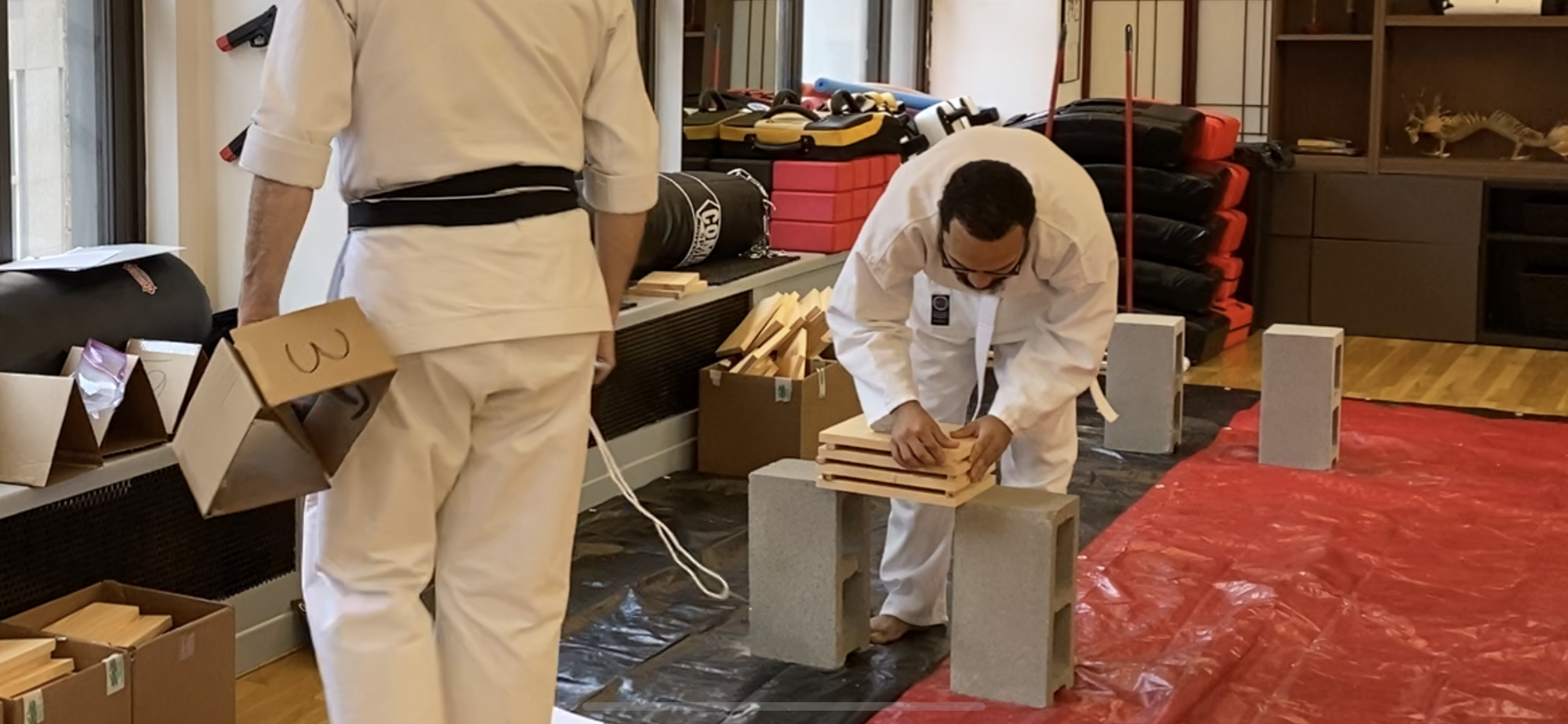

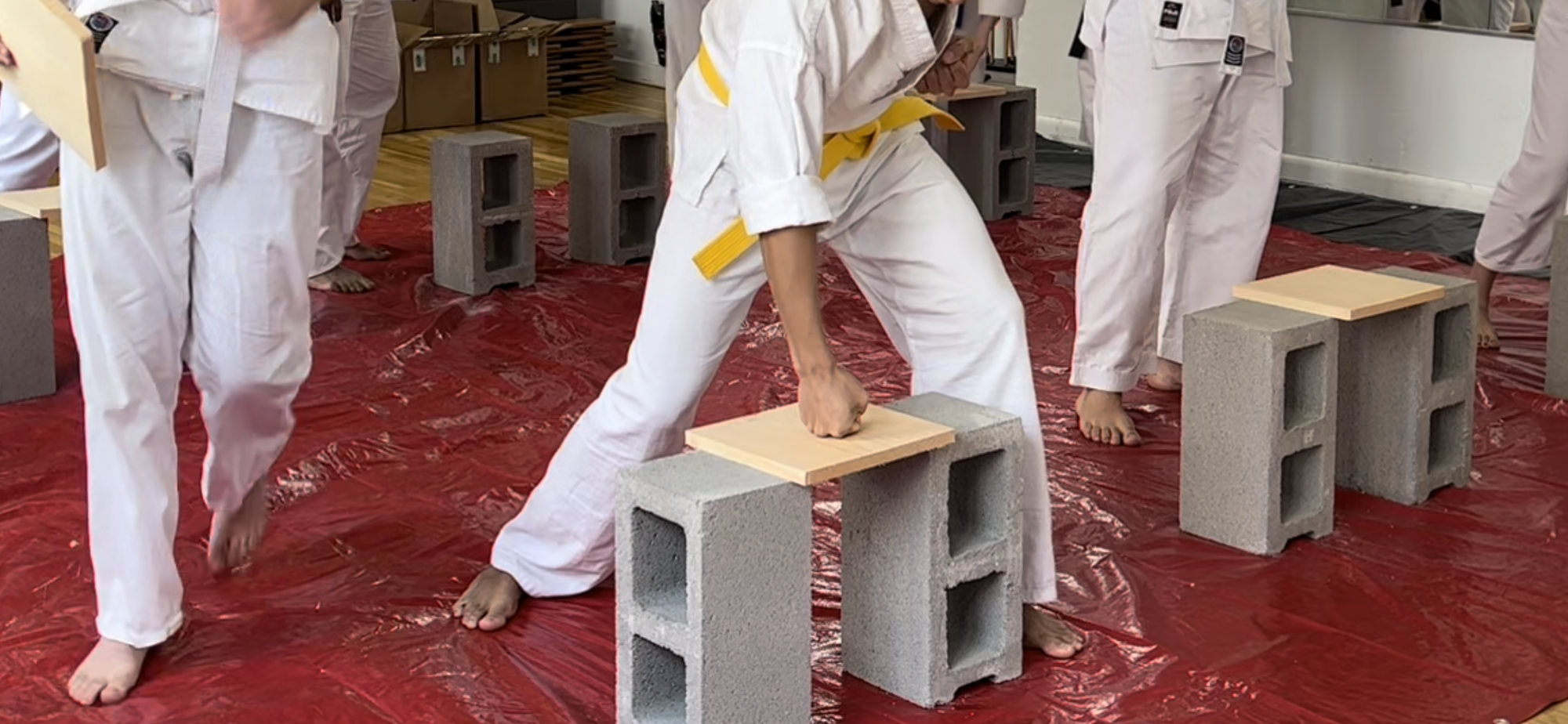
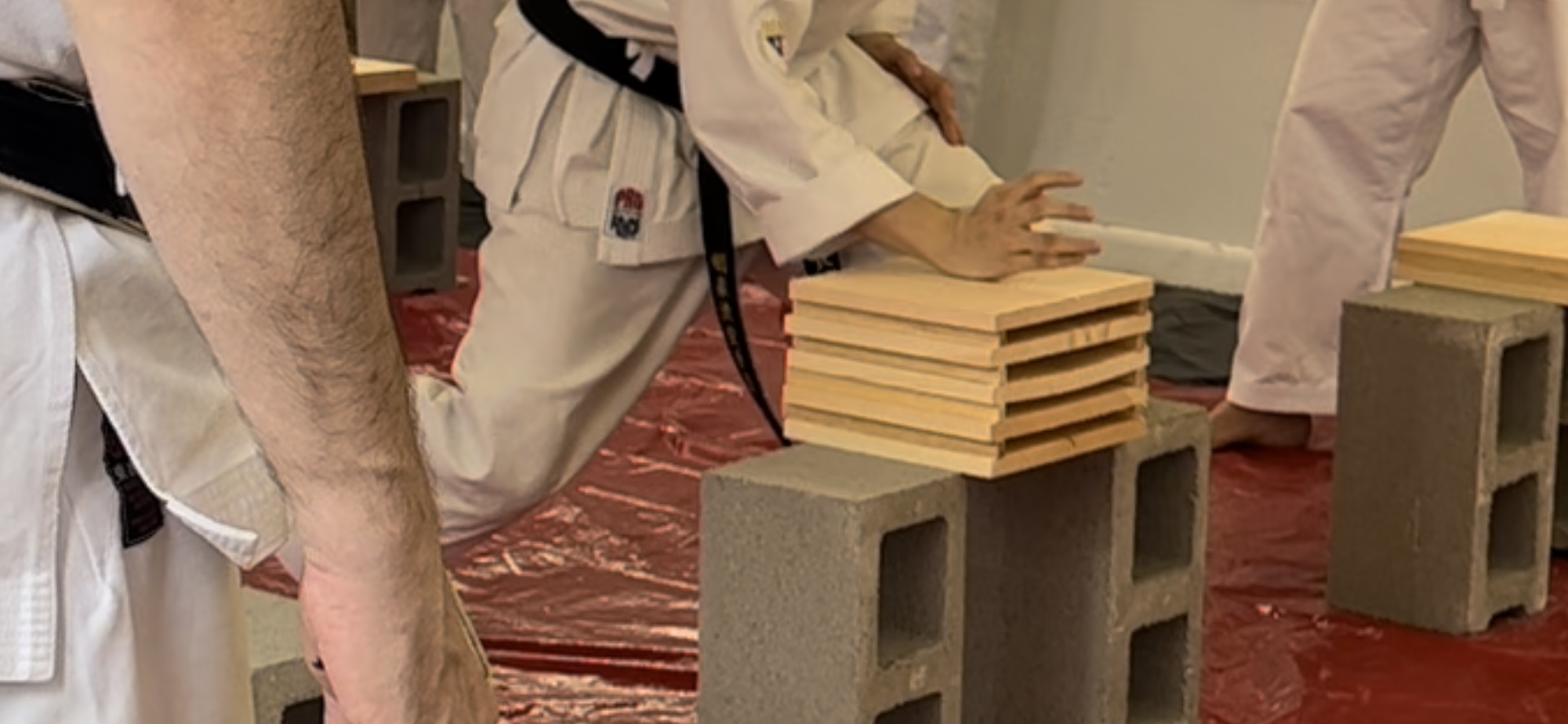


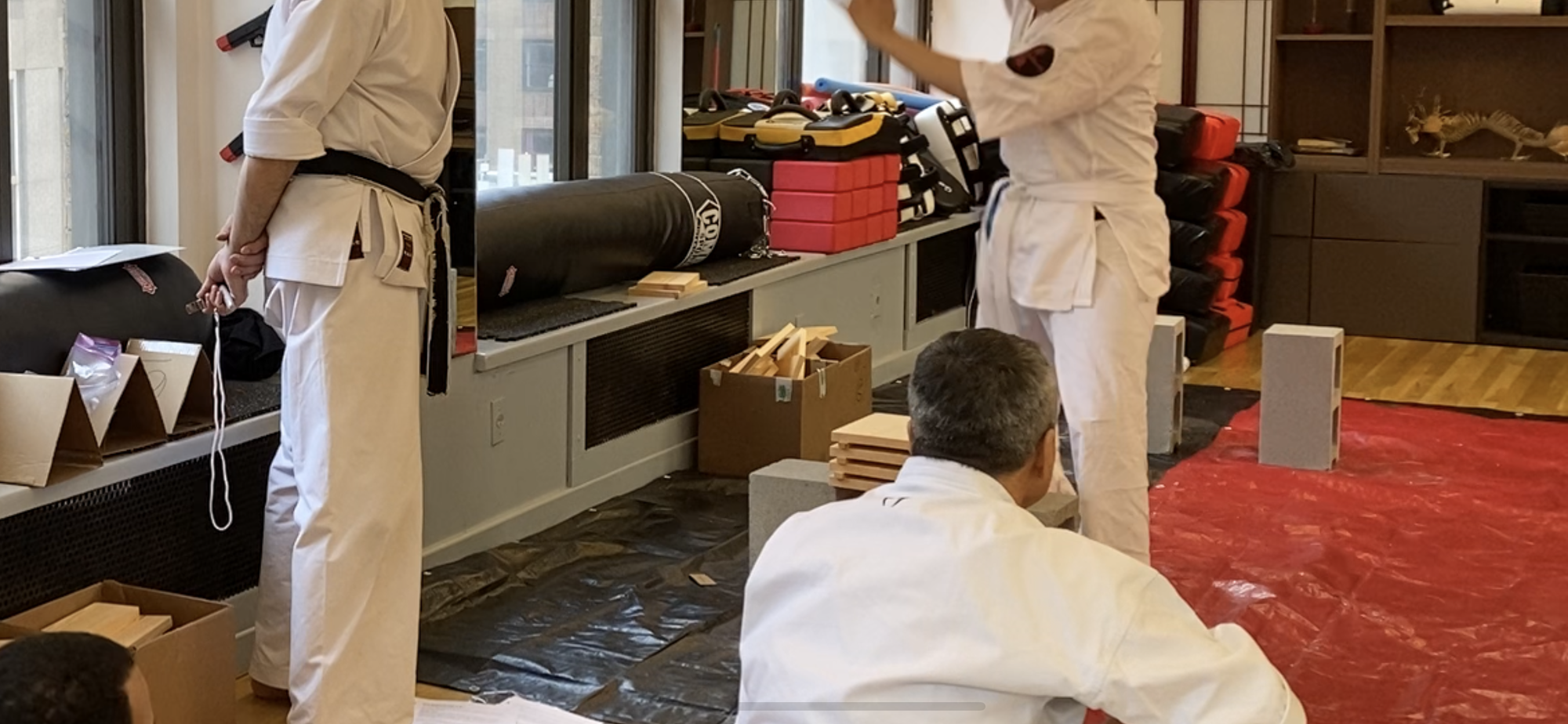
Please join us, the entire Goju Karate dojo, and all the competitors in the 2025 NYC Karatedō International Championship Tournament on November 8th and 9th, 2025. Register here.


